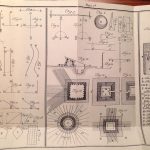From Bunker Hill to Yorktown, a feature of military actions during the American Revolution was the redoubt. Of course, redoubts were a fixture in world-wide military operations long before, and long after, that war, but those fortifications built of earth, sod and timber were usually more complex than their simple materials suggest. At a glance, a redoubt was little more than a ditch with a wall behind it built from the dirt dug out of the ditch. Some were just that, but most were more sophisticated with a great deal of thought put into the exact size, shape and placement. Locations were chosen careful to take advantage of topography and provide tactical or strategic advantage. The type of threat was important in determining whether a redoubt was fully enclosed or open on one or two sides. The size was carefully calculated based on the number of troops available to man it.
The angles of the walls and slope of the faces were, when possible, carefully calculated to provide the best field of fire. The interior face of the walls might be shaped with a step so soldiers could fire over the top then step down for protection. The approaches were cleared of vegetation and other obstructions for at least a musket-shot distance. Woody brush was tied into tight bundles called fascines, or woven into cylindrical baskets called gabions, which were used to face and reinforce the walls. Turf was laid down over the dirt to prevent erosion. Sharpened stakes might be implanted into the exterior slopes as impediments to attackers, with other obstacles formed of felled trees with sharpened branches placed farther in front to slow anyone approaching. A host of other features could be added, especially if artillery was available, and redoubts could be placed in carefully laid out networks.
Military engineers spent years learning how to design redoubts and to supervise their construction, but even infantry company officers did well to have some basic education in creating earthworks. You never know when you might have to throw up a hasty redoubt to defend a key position! Where does a young man obtain that knowledge? From any of a number of handy reference books published throughout the eighteenth century. While classic tomes like Sébastien Le Prestre de Vauban’s Manual of Siegecraft and Fortification (translated into many languages from the original French) and John Muller’s The Attac and Defence of Fortified Places went into exhaustive detail, pocket-sized volumes like Jean Louis le Cointe’s The Science of Military Posts for the use Regimental Officers (translated from French into English and published in London in 1761) provided quick information that could be applied on the small scale that typified warfare in America.
These images show the fold-out diagrams from le Cointe’s The Science of Military Posts, a portion of the table of contents from that book, and a plate from the 1757 London edition of Muller’s The Attac and Defence of Fortified Places showing various tools and constructions used for building and attacking redoubts.












3 Comments
The simplest, most practical and most useful to non-engineering officers work on the construction of field fortifications is J. C. Pleydell’s “An Essay on Field Fortification; Intended principally for the Use of Officers of the Infantry” (London, J. Nourse, 1768). Pleydell was an officer in the 12th. Regiment of Foot. His essay is easier to understand, and his methods easier to actually implement in the field than any of the many other military engineering treatises that I have in my library.
The West Point complex is a perfect example of supporting redoubts. On the east bank of the Hudson River in the hills above Garrison, two redoubts covered the fortress. http://vartika-hiking.blogspot.com/2012/10/north-and-south-redoubt.html. On the west bank where USMA is situated, a system of these small forts would make any invader vulnerable no matter which part of the fortress was attacked. http://www.hudsonrivervalley.org/library/pdfs/articles_books_essays/westpointredoubts_cubbison.pdf. Redoubt #3 high above West Point gives the visitor a stunning view of the river and despite its ruined condition offers a lesson on why these constructions were so important and how they were made (this one has a considerable foundation of rock). Also noteworthy is the surrounding vegetation. Perched on a high ridge, there’s a clear line of fire to the forts it was intended to cover far below a and this would be a very difficult approach for any attack. The gentle, heavily treed slope to the west was the only sensible approach. It’s still evident that this line of fire had been cleared of trees because the tree density is less than the other two sides of the old fortification. Well worth a visit.
There is a pristine British redoubt in Berkeley County SC that was built soon after April 14, 1780. The fort was laid out according to the compass points and has many internal features. It is an amazing structure, also amazing that it has survived. Efforts are under way to preserve it. Please help us. For more information go to this website http://www.hmdb.org/marker.asp?marker=53883
Doug Bostick is working to preserve this redoubt. in**@sc*****************.org